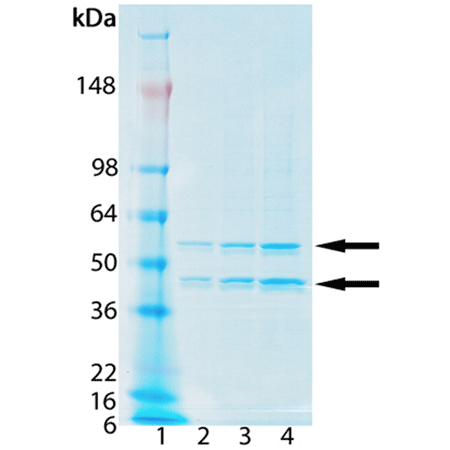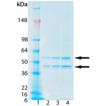Approximately 1:1 stoichiometric complex of recombinant human HDAC3 (histone deacetylase 3) with a GST fusion protein comprising the Deacetylase Activation Domain (DAD) of human NCOR1 (amino acids 397-503; SANT1 domain plus amino flanking residues). Produced by coexpression of HDAC3 with a GST-NCOR1(DAD) construct in an insect cell system, the complex displays ~100-fold higher deacetylase activity than isolated HDAC3 (based on equal weights HDAC3 assayed at a saturating concentration (100µM) of a fluorogenic peptide substrate p53 379-382, K(Ac)382; Prod. No. BML-KI177).This HDAC3 preparation is active with various fluorogenic peptide substrates, including FLUOR DE LYS® Substrate (Prod. No. BML-KI104) and FLUOR DE LYS®-SIRT1 (p53 379-382, K(Ac)382; Prod. No. BML-KI177).
Product Details
| Alternative Name: | Histone deacetylase 3/Nuclear receptor corepressor 1 |
| |
| MW: | 49/40 kDa |
| |
| Source: | Produced in insect cells. Produced in a baculovirus expression system. |
| |
| UniProt ID: | O15379 (HDAC3), O75376 (NCOR1) |
| |
| Gene/Protein Identifier: | NM_003883, NM_006311 (RefSeq) |
| |
| Formulation: | Liquid. In 50mM TRIS, pH 8.0, 138 mM NaCl and 10% glycerol. |
| |
| Purity: | ≥90% (SDS-PAGE) |
| |
| Purity Detail: | Purified by multi-step chromatography. |
| |
| Specific Activity: | ≥150 U/µg. One U=1 pmol/min at 37°C, 100 µM, FLUOR DE LYS®-SIRT1 deacetylase substrate (Prod. No. BML-KI177). |
| |
| Shipping: | Dry Ice |
| |
| Long Term Storage: | -80°C |
| |
| Scientific Background: | HDAC3, although a class I HDAC, is found in co-repressor complexes with the SMRT/N-CoR proteins, complexes distinct from than those comprising other class I enzymes. It has a unique domain structure, including both nuclear localization and nuclear export sequences and has been assigned to its own phylogenetic subclass. Inhibition of HDAC3 may be the determining factor in the anti-proliferative effects of HDAC inhibitors on cancer cells and its caspase-dependent cleavage and relocation to the cytoplasm may be critical to the progression of apoptosis. It has been shown that HDAC3, rather than the class II HDACs 4 and 5, likely diretly deacetylates MEF2, implying an important role in pathways affecting heart disease. |
| |
| Regulatory Status: | RUO - Research Use Only |
| |

SDS-PAGE Analysis: Lane 1: MWM; Lane 2: 0.5 µg; Lane 3: 1.0 µg; Lane 4: 2.0 µg of purified HDAC3/NCOR1 complex (human), (recombinant) Protein Prod. No. BML-SE515.
Please mouse over
Product Literature References
Novel hydroxamic acid derivative induces apoptosis and constrains autophagy in leukemic cells: M.A. Fischer, et al.; J. Adv. Res. (2023),
Abstract;
Uncovering Robust Delactoylase and Depyruvoylase Activities of HDAC Isoforms: M. Zessin, et al.; ACS Chem. Biol.
17, 1364 (2022),
Abstract;
Discovery of Janus Kinase 2 (JAK2) and Histone Deacetylase (HDAC) Dual Inhibitors as a Novel Strategy for the Combinational Treatment of Leukemia and Invasive Fungal Infections: Y. Huang, et al.; J. Med. Chem.
61, 6056 (2018),
Abstract;
Small Molecule Inhibitors Simultaneously Targeting Cancer Metabolism and Epigenetics: Discovery of Novel Nicotinamide Phosphoribosyltransferase (NAMPT) and Histone Deacetylase (HDAC) Dual Inhibitors: G. Dong, et al.; J. Med. Chem.
60, 7965 (2017),
Abstract;
Histone deacetylase 3 associates with MeCP2 to regulate FOXO and social behavior: A. Nott, et al.; Nat. Neurosci.
19, 1497 (2016),
Application(s): Recombinant protein binding assay,
Abstract;
Full Text
Novel analogs targeting histone deacetylase suppress aggressive thyroid cancer cell growth and induce re-differentiation: S. Jang, et al. ; Cancer Gene Ther.
22, 410 (2015),
Application(s): Biochemical assay for inhibitory effects on selective HDACs,
Abstract;
Tumor-suppressor role of Notch3 in medullary thyroid carcinoma revealed by genetic and pharmacological induction: R. Jaskula-Sztul, et al.; Mol. Cancer Ther.
14, 499 (2015),
Abstract;
Full Text
Class IIa histone deacetylases are hormone-activated regulators of FOXO and mammalian glucose homeostasis: M.M. Mihaylova, et al.; Cell
145, 607 (2011),
Abstract;
Full Text
Related Products













